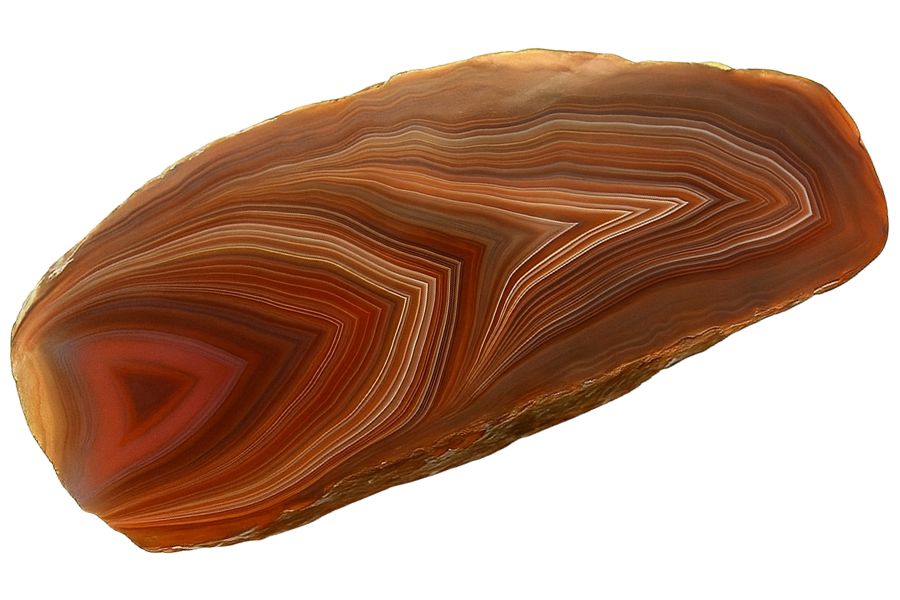Grab your boots and a bucket, because a treasure hunt for dazzling Illinois agates is waiting for you along the state’s wild waterways. This state’s rich, glacial past means that rivers and creeks carry minerals from far away, including agates.
Keep your eyes peeled for pieces that show a wonderful transparency when wet or reveal vibrant colors. A few great places to check out the gravels are near the Mazon River or any major creek running through glacial deposits.
You can also sometimes spot unique specimens along the shores of Lake Michigan, where the waves are constantly tumbling new stones onto the beach.
It’s a relaxing, rewarding, and a fantastic way to enjoy the outdoors! With some guidance and a little patience, you might uncover an amazing collection of agates and see firsthand how knowledge turns curiosity into discovery.
We’re going to cover:
- The types of agates you can find in Illinois
- How you can find and identify them
- The best places to look for agates
- Common agate hunting questions and tips
- Some of the rules and regulations to be aware of
What is Illinois Agate?
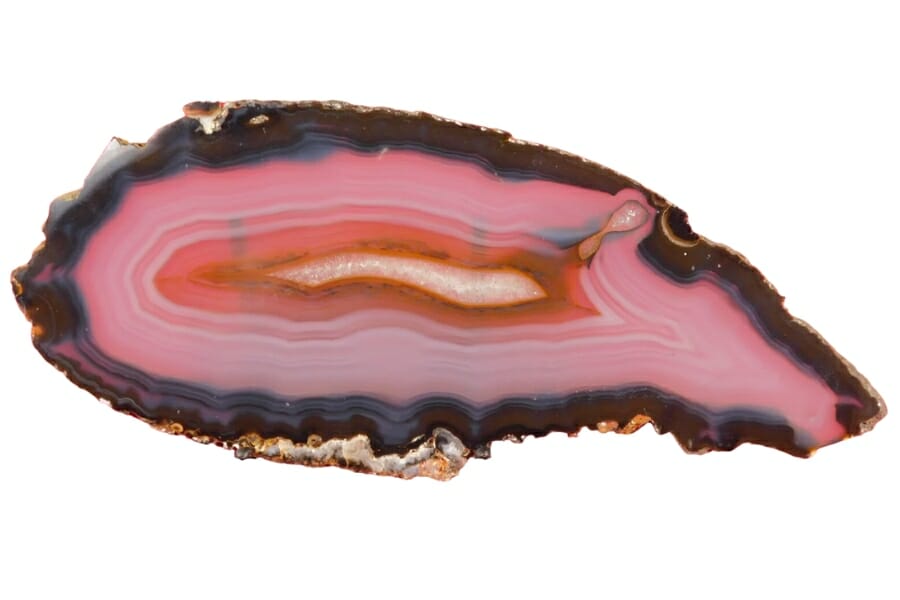
Imagine a stone that looks like it has frozen ribbons of color inside— that’s what an agate looks like. It’s a type of quartz, and what makes it special is its bright, wavy lines and patterns.
So, where do these gems come from? They form in volcanic rock or ancient lava. When the lava cools down, spaces or bubbles are left behind. Over time, minerals fill these spaces, layer by layer, and voila! We get these lovely agates.
This natural wonder’s aesthetic appeal and uniqueness (did we mention that no two agates are exactly alike?) are among the many factors that affect agate’s value and price in the market.
If you’re in Illinois or planning to visit, you’re in for a treat! Our state has its own share of these colorful gems. But before we go into the details of where they are exactly, let’s first discuss the different types of agates that you might encounter:
Blue Lace Agate
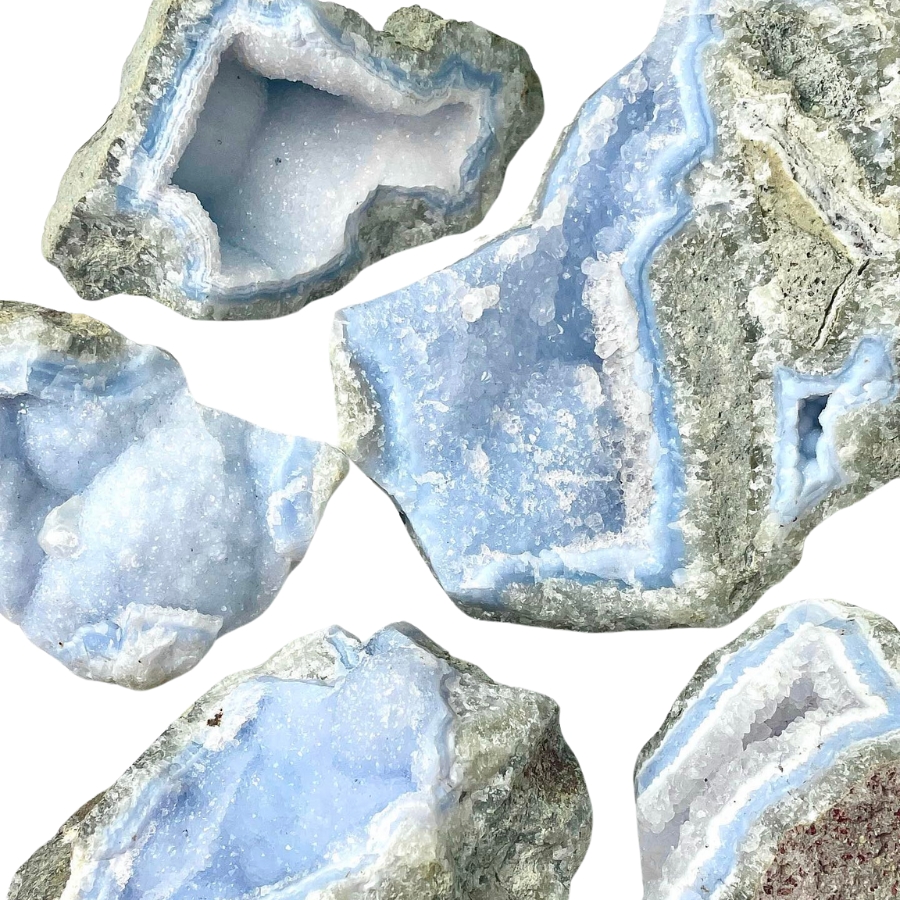
Blue lace agate is like the soft, sky-blue waves with lines that swirl and twist like delicate lace.
Its pattern comes from slow-forming layers of quartz, which create those beautiful, lace-like bands.
The bands of this agate type are often in shades of light blue, white, and sometimes a bit of grey. It’s different from other agates, which usually have more intense colors and stronger patterns.
The value of blue lace agate lies in its soft, tranquil look and the feeling of calm it brings. It’s often used in jewelry or as a decorative stone.
If you want REAL results finding incredible rocks and minerals you need one of these 👇👇👇
Finding the coolest rocks in isn’t luck, it's knowing what to look for. Thousands of your fellow rock hunters are already carrying Rock Chasing field guides. Maybe it's time you joined the community.
Lightweight, mud-proof, and packed with clear photos, it’s become the go-to tool for anyone interested discovering what’s hidden under our red dirt and what they've already found.
Join them, and make your next rockhounding trip actually pay off.
What makes it different:
- 📍 Find and identify 140 incredible crystals, rocks, gemstones, minerals, and geodes across the USA
- 🚙 Field-tested across America's rivers, ranchlands, mountains, and roadcuts
- 📘 Heavy duty laminated pages resist dust, sweat, and water
- 🧠 Zero fluff — just clear visuals and straight-to-the-point info
- ⭐ Rated 4.8★ by real collectors who actually use it in the field
Moss Agate
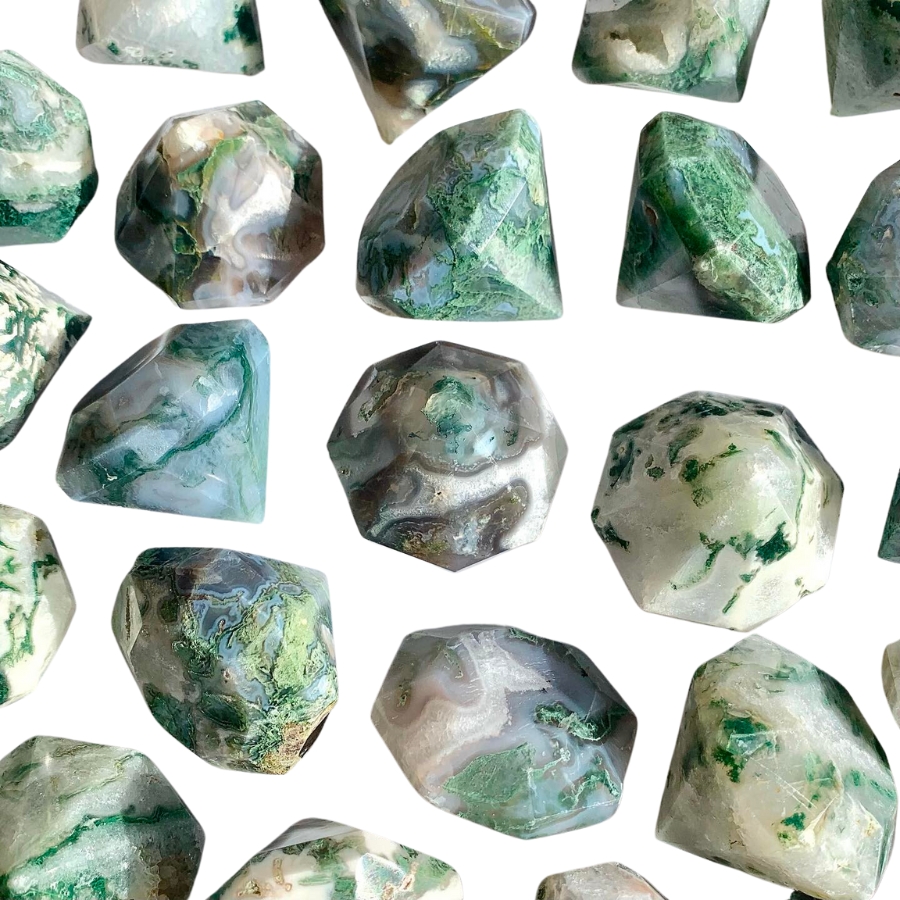
Instead of having the typical banding for which the different types of agates are known, moss agate has green inclusions that look like moss or trees.
These green patterns aren’t real plant material, though. They’re minerals like chlorite or iron oxide.
In some cultures, this type of agate is known as the “gardener’s stone” because of its green, plant-like appearance. It’s believed to help plants grow.
The price of moss agate can vary. It’s often quite affordable, but the more distinct and picturesque the green patterns, the more it might cost.
Fire Agate
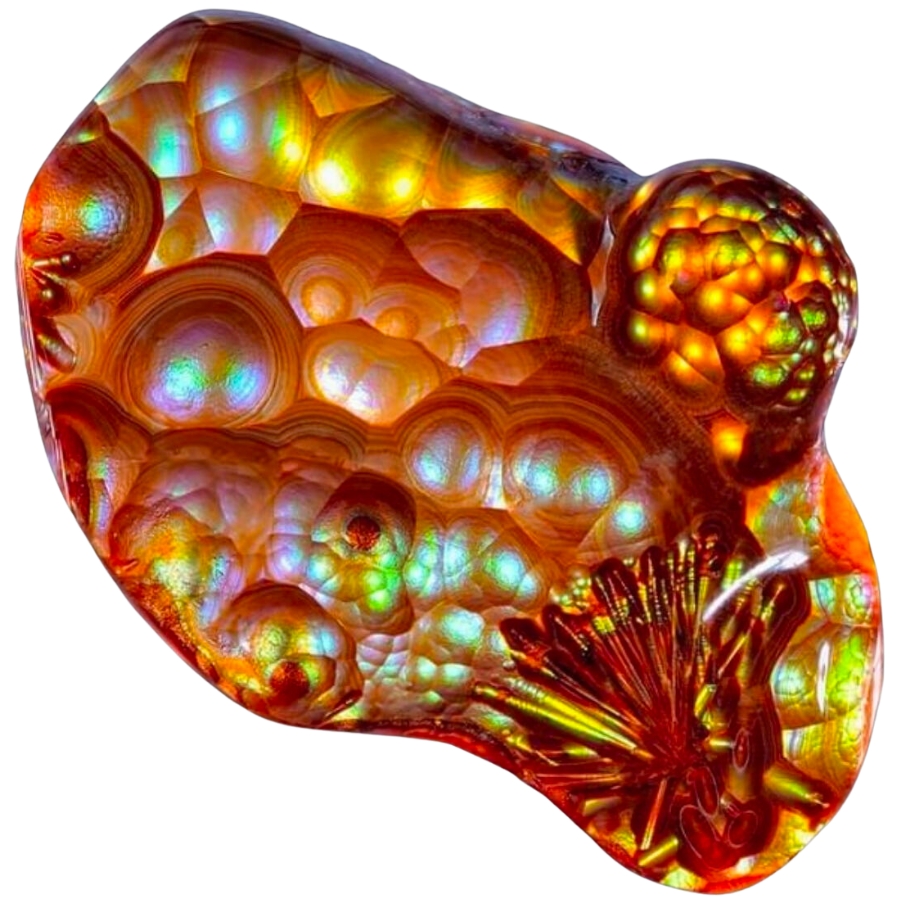
Fire agate is known for its incredible colors and the way it sparkles like fire. It’s got layers of silica and iron oxide that reflect light, creating a fiery effect.
When you look at fire agate, it’s like seeing flames trapped inside. Its colors can range from reds and oranges to greens and golds, all shimmering under the surface.
You might be wondering, “What is fire agate worth?” Well, its value comes from its rare beauty. The more color and sparkle, the more valuable the stone is.
Its fiery iridescence and lively play of color are used in jewelry pieces that are meant to stand out.
Dendritic Agate
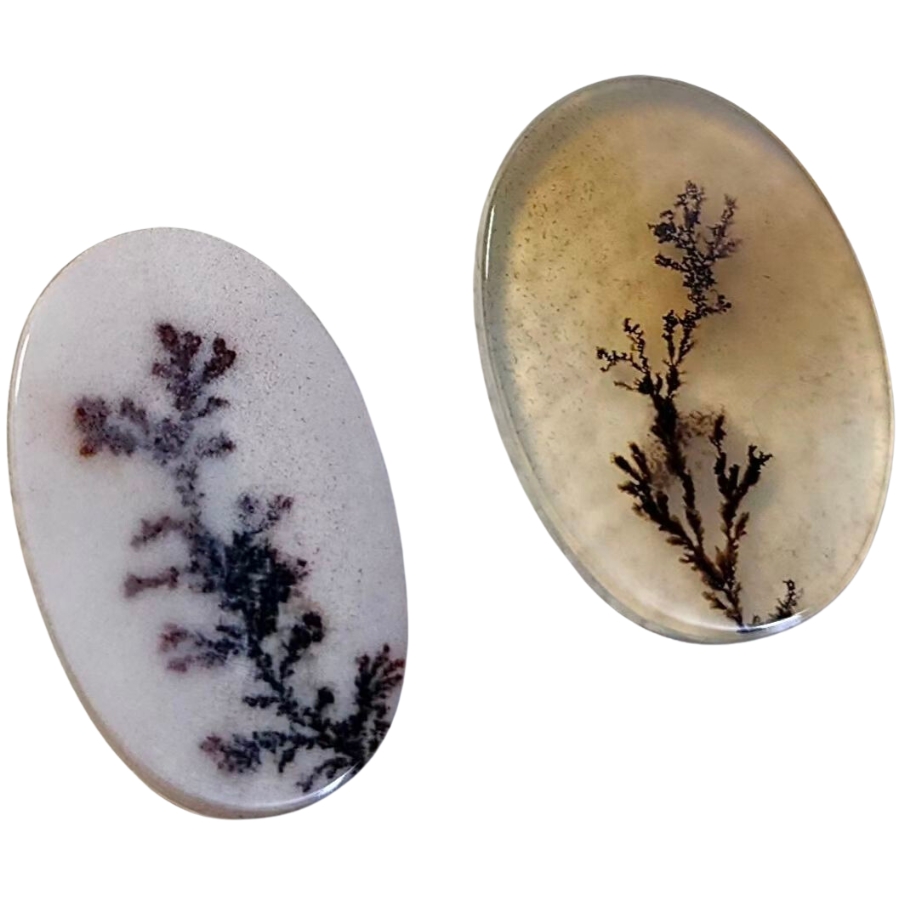
Dendritic agate is known for patterns that look like tiny trees or shrubs. Like moss agate, these patterns aren’t actual plants. They’re made of minerals, mostly manganese or iron oxides.
When you look at a dendritic agate, it’s like peering into a miniature forest or a frosty winter landscape.
The base of the stone is usually translucent to opaque, and the “dendrites”— those tree-like patterns— are often black or brown.
When it comes to how much dendritic agate is worth, it can vary. The more detailed and distinct the patterns are, the more it’s usually valued.
In some cultures, dendritic agate is believed to bring fullness and richness to life.
Crazy Lace Agate
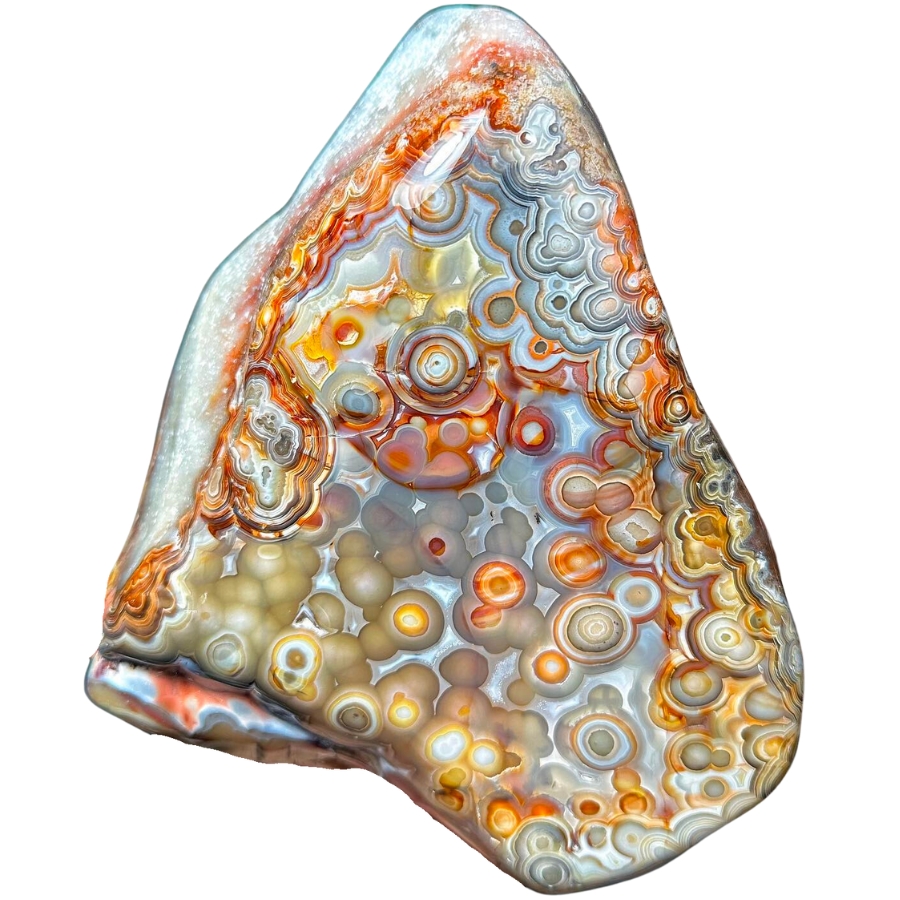
Crazy lace agate is like a party in a rock! It’s got swirls, circles, and all sorts of wild patterns dancing across it.
Its colors can be a mix of red, orange, yellow, and brown, and sometimes even a bit of gray or white.
What makes crazy lace agate stand out is its vibrant and complex patterns. No two pieces are the same. This distinctiveness is a big reason why it’s so valued.
Despite its wild and ‘crazy’ appearance, it’s sometimes called the “Laughter Stone” or “Happy Lace” because of the joy and positive vibes it’s believed to bring.
Laguna Agate
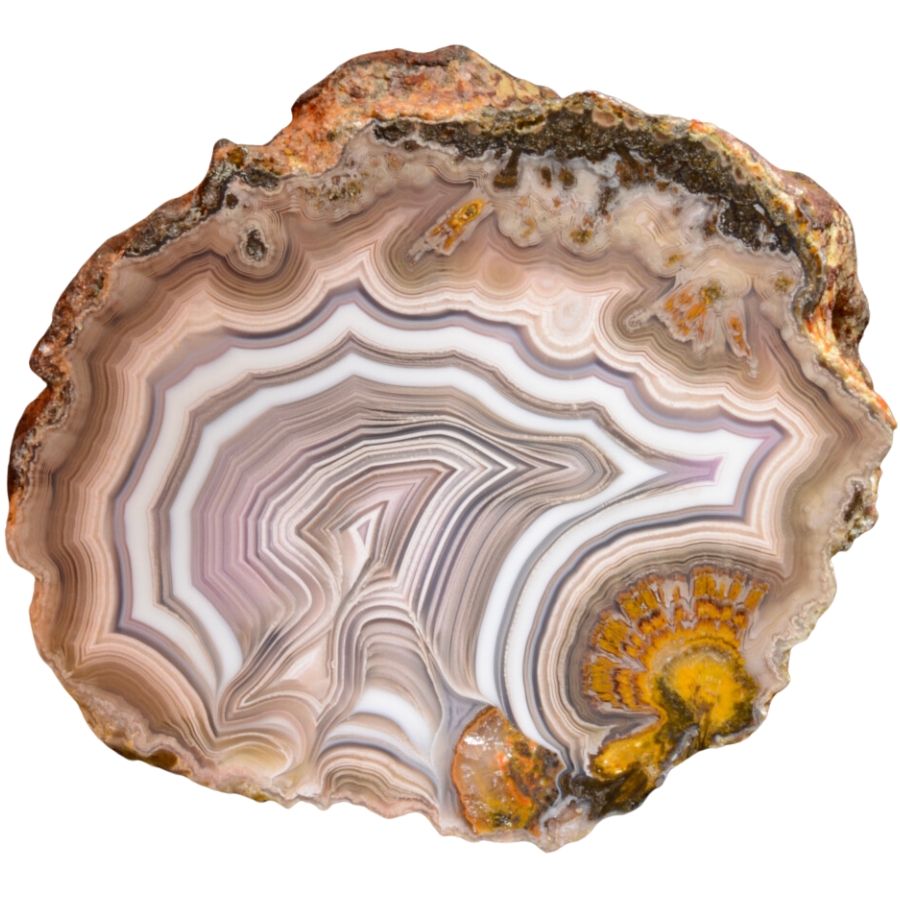
Laguna agate has incredibly sharp and fine banding. It has layers of red, orange, pink, yellow, and sometimes even purple and white all stacked in neat, tight bands.
These bands can form eye-catching patterns, like swirls, loops, and even landscapes.
The different colors of its bands come from various minerals present in the water at the time of its formation.
Laguna agate is considered one of the finest agates in the world due to its exceptional banding. This high regard among agate varieties makes it a prized possession for collectors.
Condor Agate
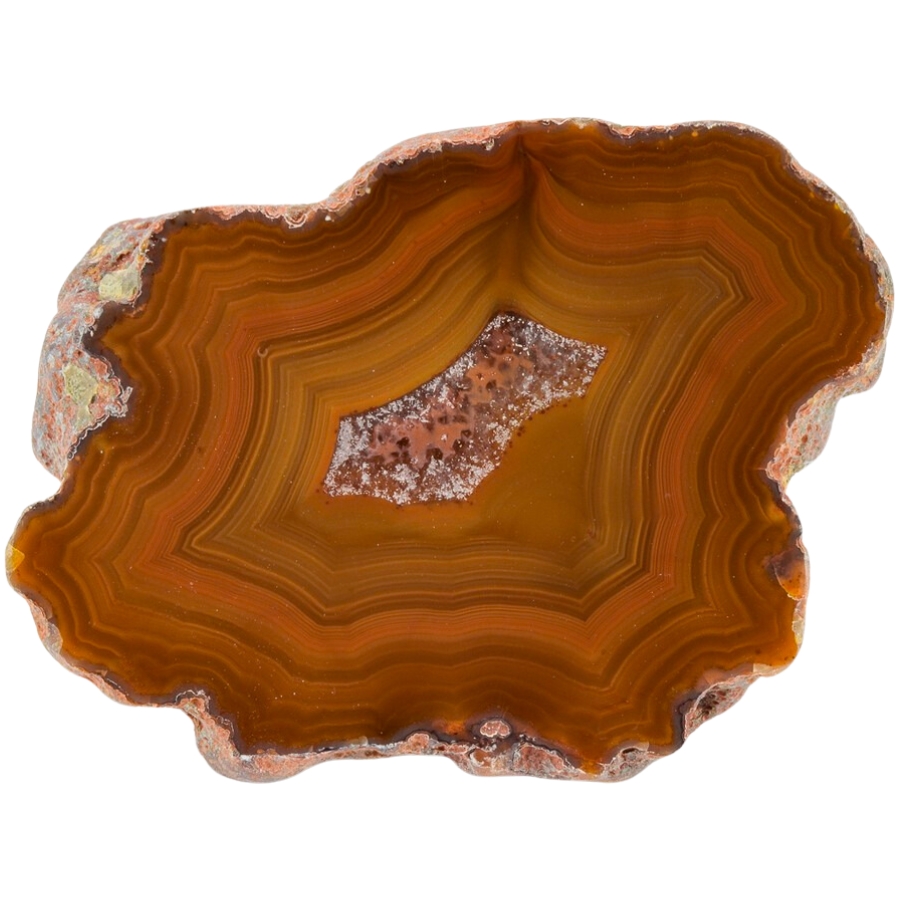
Condor agate is a real standout. It’s known for its bright, vivid colors and complex patterns.
It has reds, oranges, yellows, and sometimes even blues and greens all swirling together. These colors form in bands or in more random, artistic patterns.
The intensity and variety of its colors is what makes condor agate so special. It’s often used by artists and craftsmen who want to make a statement with their work.
Condor agate’s bold colors and patterns can turn a simple piece of jewelry or art into something really eye-catching.
Fortification Agate (Banded Agate)
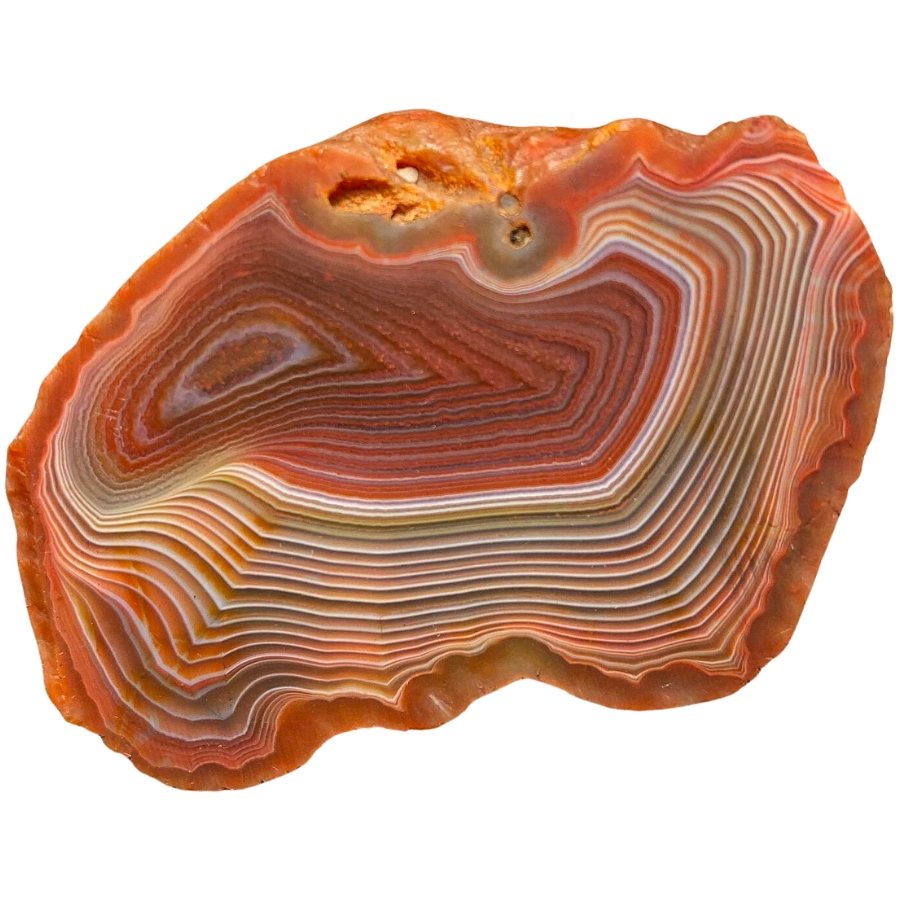
Fortification agate gets its name because the patterns inside it look like the aerial view of a fortified city.
Imagine seeing bands of color forming shapes that look like walls, with sharp angles and curves. They are usually in different colors, making each layer stand out.
If fortification agate is valuable, it’s because of its distinct patterns and colors. Its unique look makes it sought after for jewelry and as a collector’s item.
The clearer and more defined the patterns, the more valuable the stone can be. Some people also believe it can help with relaxation and calmness.
Iris Agate
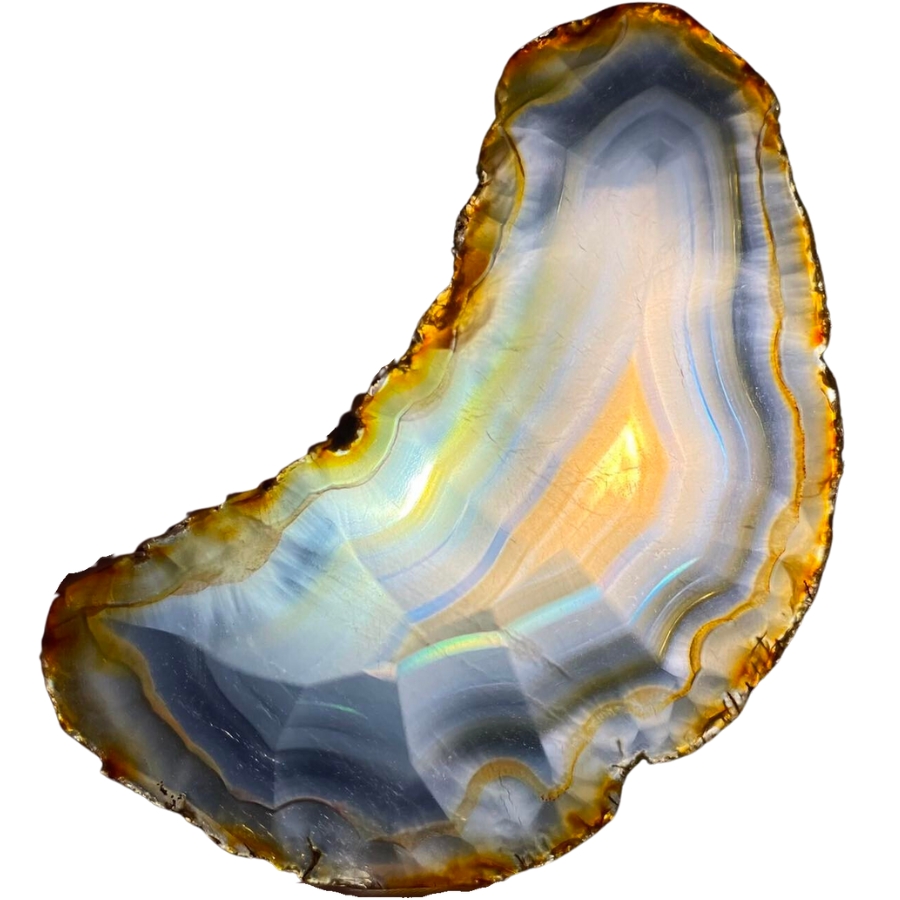
Iris agate looks like a regular agate at first, but when you hold it up to the light, something amazing happens. It shows all these rainbow colors, like light passing through a prism.
This is because it has very thin layers of silica, and when light hits these layers, it splits into all the colors of the rainbow.
The formation of iris agate is similar to other agates, but its layers are super thin, which is what creates the rainbow effect.
The value of iris agate comes from its unique ability to show these colors. In the past, people even used to think it had magical properties because of the way it showed colors. They saw it as a stone of good luck and wonder.
Plume Agate
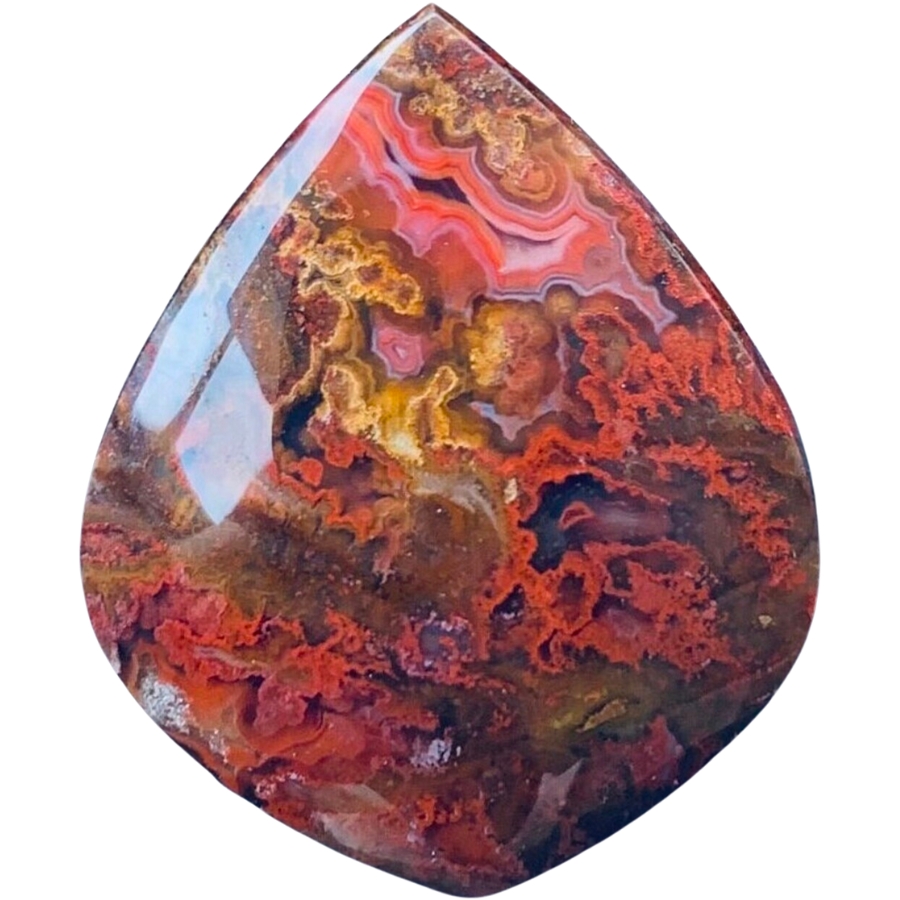
Plume agate gets its name from its patterns that look like soft, feathery plumes. These plumes can be in all sorts of colors: red, black, green, or yellow, set against a translucent or opaque background.
The way these plumes seem to float in the stone makes it look like a frozen underwater scene or like feathers caught in a breeze.
The plumes are made of minerals like manganese or iron oxide, which get trapped in the silica during the agate’s formation and create the feathery patterns.
The price of plume agate can vary depending on how clear and intricate the patterns are. The more detailed and colorful the plumes, the more the stone is usually worth.
Picture Agate (Scenic Agate)
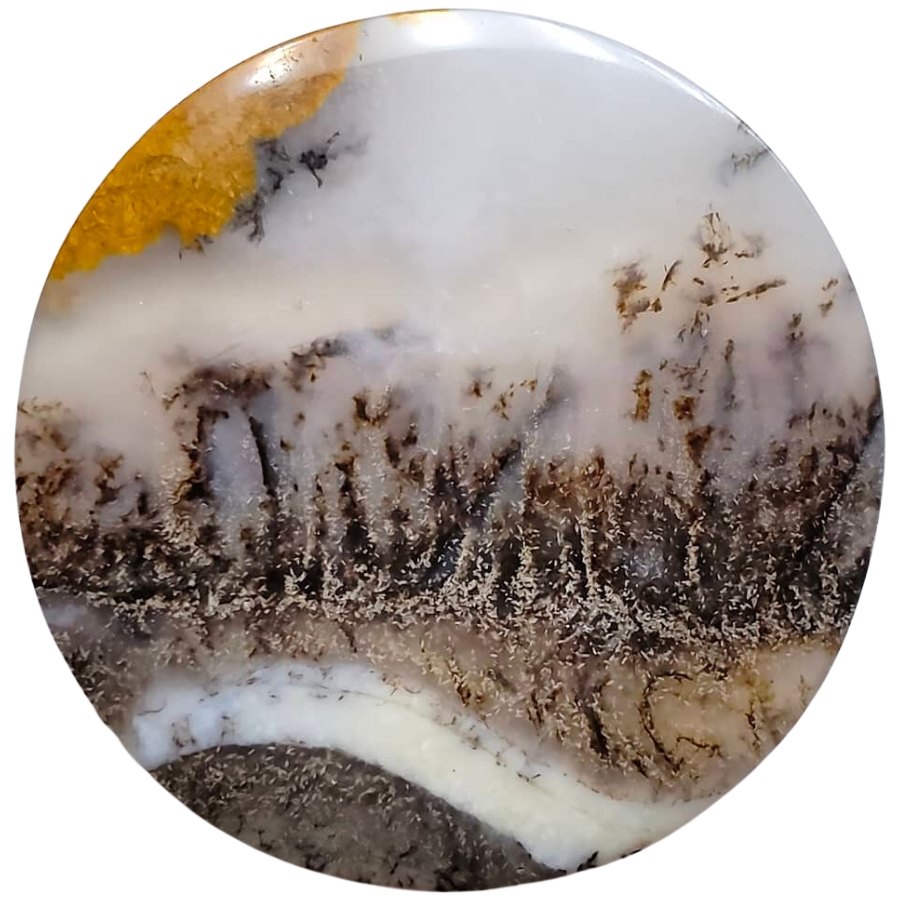
Picture agate is like a snapshot of nature captured in stone because it looks like it has pictures or scenes right inside it.
These “pictures” are actually natural patterns that resemble landscapes, mountains, trees, or even skies. They are usually in different shades of brown, white, and gray against a more translucent background.
The different patterns in picture agate or what’s also called scenic agate are made by various minerals in the water filled with silica that forms it.
If you’re thinking, “What is picture agate worth?“, its value comes from how distinct, clear, and detailed the natural “pictures” are.
Turritella Agate
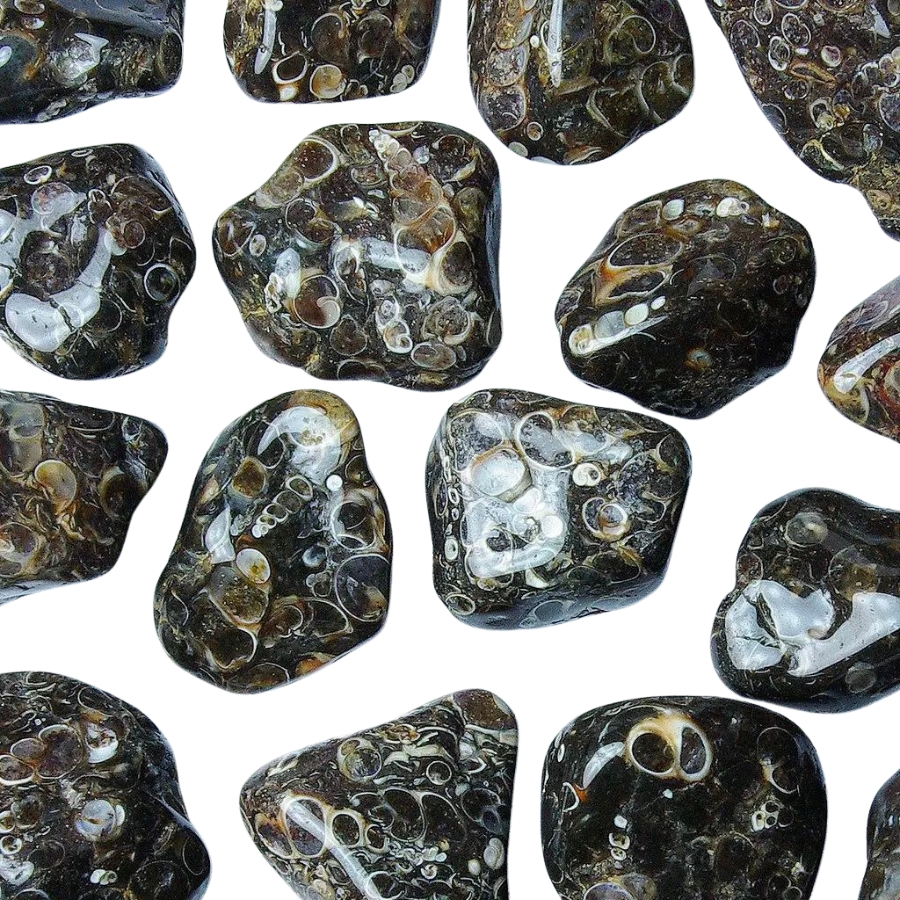
Turritella agate is not your typical agate because it’s full of fossilized snail shells! The shells belong to a creature called Turritella, a type of sea snail.
These shells are tightly packed and create a pattern that looks like a bunch of tiny, swirling towers. The background of the agate is usually a dark, earthy color, which makes the white or cream-colored snail shells really pop.
Over millions of years, these snail shells got buried in sediment and eventually became fossilized. As time went on, silica-rich water flowed through the sediment, turning it into the agate we see today.
The value of turritella agate comes from its unique blend of geology and history. More than a pretty stone, it’s a piece of ancient life preserved in rock.
Fairburn Agate
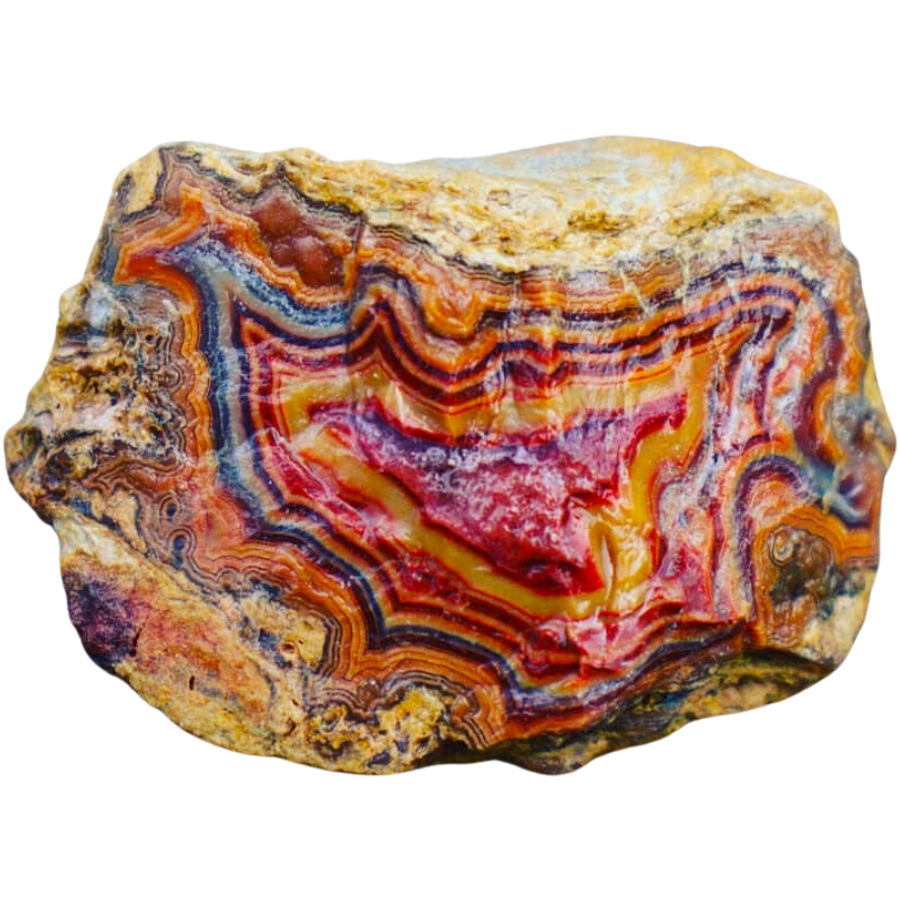
Known for its intricate patterns and bold colors, Fairburn agate is another fascinating type of agate. It usually has bands and swirls of different colors like red, yellow, orange, brown, and sometimes even pink or purple.
What’s special about these patterns is they often look like they’re in layers, creating a 3D effect. It’s like looking at a landscape made of stone.
It’s named after a place called Fairburn in South Dakota. This gives a clue about where it was first discovered.
People value Fairburn agate for the skill it takes to cut and polish it, which makes the patterns and colors really stand out.
Sagenite Agate
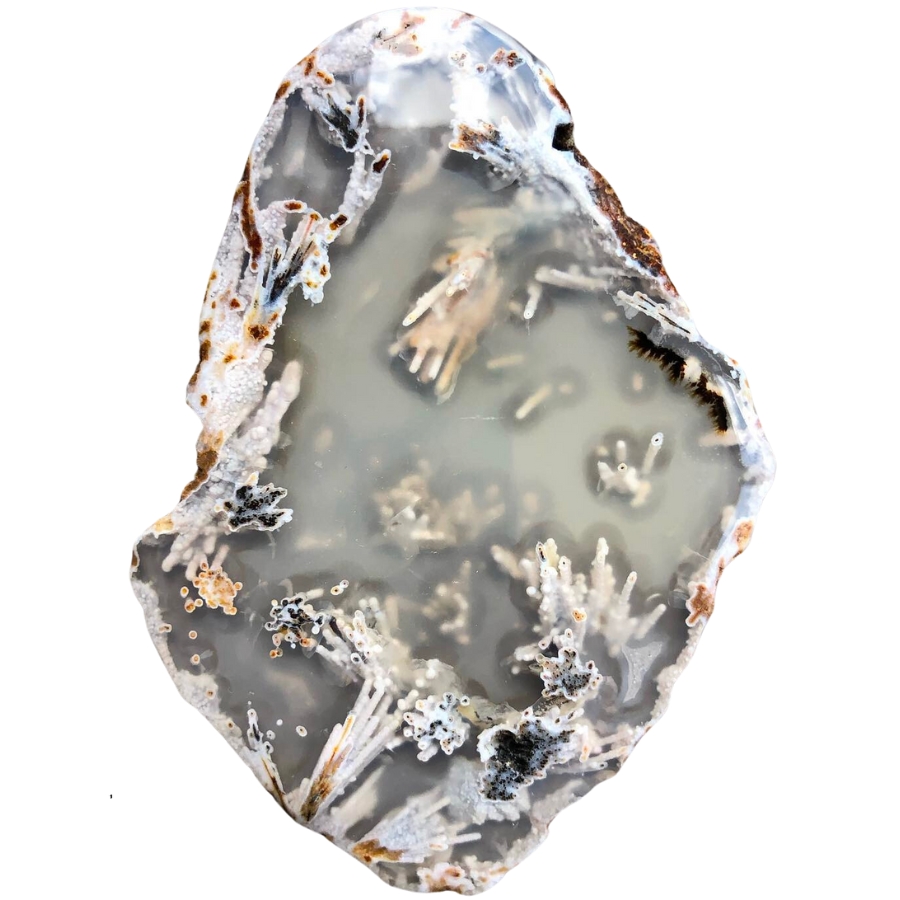
Sagenite agate has needle-like inclusions that look like tiny sprays of crystals inside it. They can be gold, silver, black, or even green, and they spread out in all directions, creating an amazing pattern.
The base of the agate is usually translucent, which lets you see these intricate needle patterns clearly.
These patterns are actually other minerals, like rutile or goethite, that get trapped inside the forming agate. These minerals grow in a crystal shape, looking like needles or hair.
Sagenite agate is often used in jewelry and other decorative items, with some people thinking that its needle patterns look like fireworks or starbursts.
Tree Agate
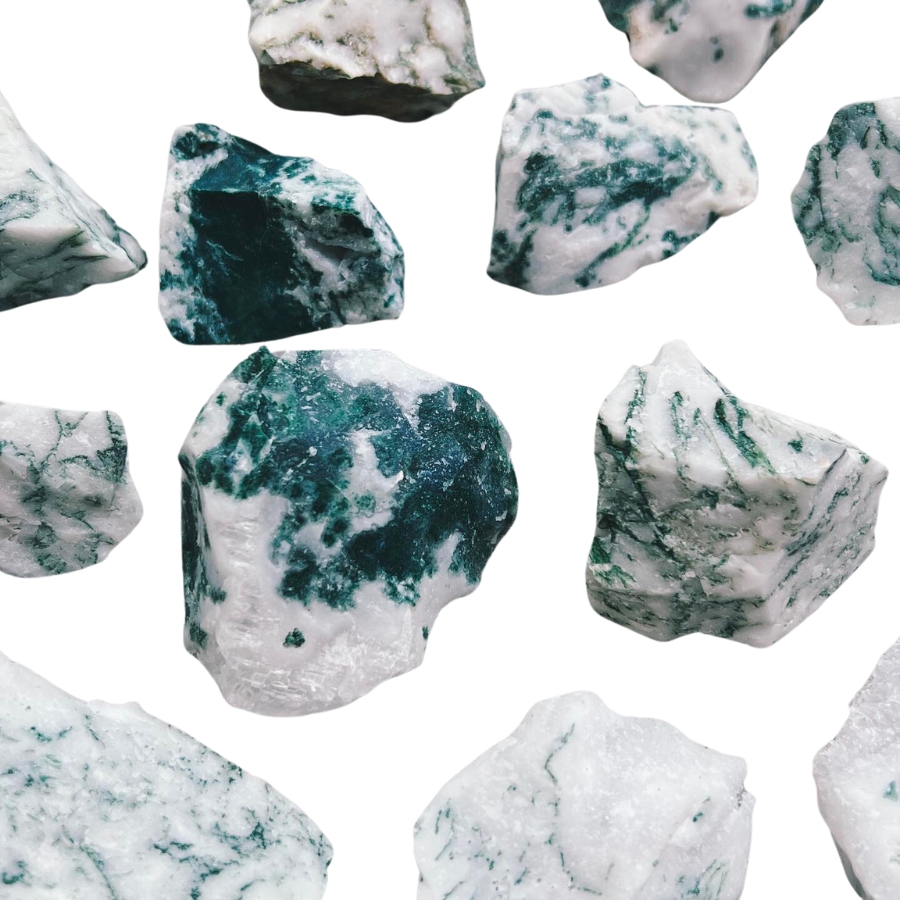
Tree agate, as its name suggests, looks like it’s got tiny trees or branches inside it. These tree-like patterns are usually green and spread out against a white or light gray background.
The green patterns aren’t actual trees, though. They’re made of minerals like chlorite or manganese.
Each piece of tree agate is different. You won’t find two that are exactly the same. It’s valued for its looks and it’s often used in jewelry and decorations.
The key factors in our recommendations are:
- The deep experience and understanding of our team about the area
- Recommendations from local groups and clubs
- How easy it is to get the a particular location
- Safety and potential hazards when collecting
- Weighing private and public locations
- The ability for both experienced and novice agate enthusiasts to find great samples
With these factors in mind we’ve been able to put together a fantastic list that just about anyone can use!
Kids. Beginners. Pros. Doesn’t matter. This book has become the go-to because it works for everyone.
Magy put it bluntly: “Identify rocks, crystals and minerals is so easy now!”
That’s not by accident, the photos are crisp, the callouts are simple, and the design is rugged enough to throw in a backpack without worrying. Whether it’s your first geode or your hundredth, this guide keeps the fun part simple: finding more treasures.
The Best Spots To Find Agates in Illinois
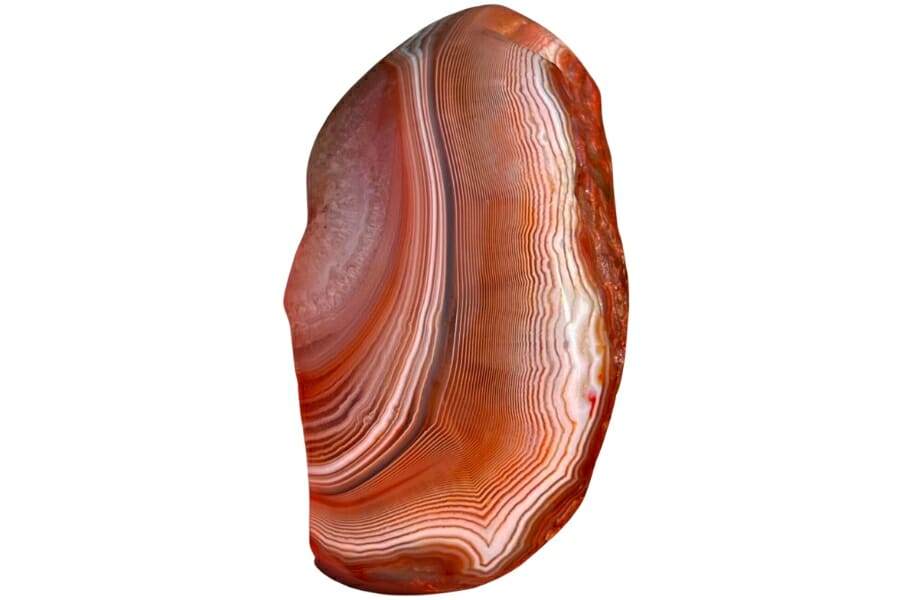
It’s true that Illinois has some pretty awesome gem mine sites, but not all of them have agates. If you’re laser-focused on finding Illinois agates, below are the guaranteed sites for you to explore:
Always Confirm Access and Collection Rules!
Before heading out to any of the locations on our list you need to confirm access requirements and collection rules for both public and private locations directly with the location. We haven’t personally verified every location and the access requirements and collection rules often change without notice.
Many of the locations we mention will not allow collecting but are still great places for those who love to find beautiful rocks and minerals in the wild without keeping them. We also can’t guarantee you will find anything in these locations since they are constantly changing.
Always get updated information directly from the source ahead of time to ensure responsible rockhounding. If you want even more current options it’s always a good idea to contact local rock and mineral clubs and groups
Mississippi River

Mississippi River is one of the grandest rivers in America, and Illinois is lucky to share over 580 miles of its shoreline! Running along our western edge, the river creates a natural border between Illinois and our neighbors, Iowa and Missouri.
As the river meanders, it shapes the land, carving deep valleys, creating bluffs, and leaving behind flat floodplains. These features make the river’s edge in Illinois a mix of stunning cliffs, lush forests, and fertile farmlands.
Over the years, the river has uncovered layers of sedimentary rocks like limestone and shale. And nestled among these layers, you can find beautiful agates.
With several highways and roads leading to the Mississippi River, access is easy. Towns like Quincy, Alton, and Rock Island are gateways to the river. Each of these towns has parks, lookout points, and recreational areas. But before you visit here, it’s a great idea to review Illinois’ updated collecting guidelines.
Where we found agates in the Mississippi River
There are different specific spots within the length of the Mississippi River where you can find agates, such as:
- Banks in Cordova
- Area gravel deposits, pits, and bars in Thebes
- East bank from Whiteside County border to Savanna Army Depot
- East bank from the Henry County border upstream to the Carroll County border
Hamilton
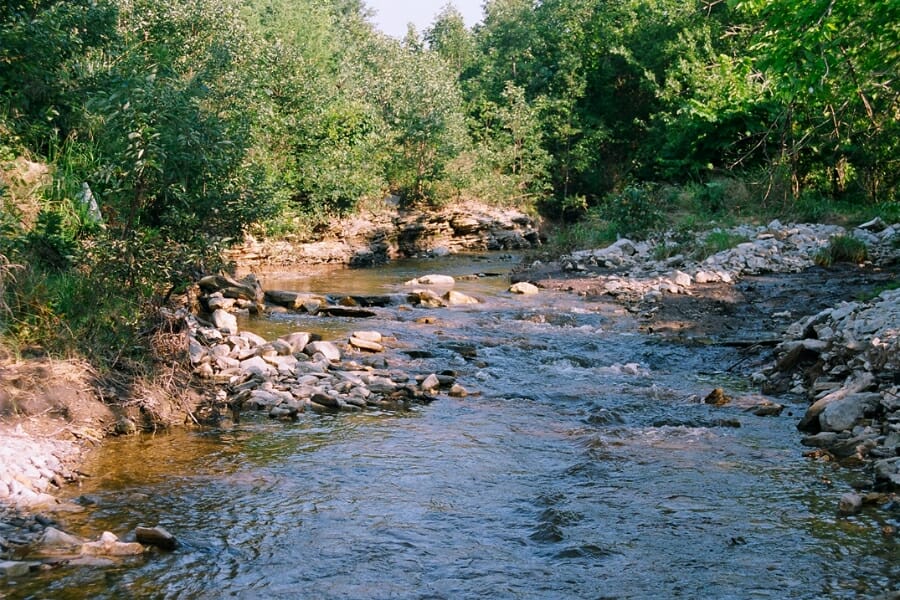
Hamilton is a delightful town situated in west-central Illinois, right on the banks of the mighty Mississippi River. Being so close to the river, this town enjoys picturesque views and a landscape. The terrain here is a mix: think gentle hills, stretches of flatlands, and the occasional bluff or cliff offering panoramic river views.
The geology of Hamilton and its surroundings is super intriguing! The area boasts of sedimentary rock formations like limestone and shale. Amidst these rocks, you can discover agates.
If you’re wondering about getting to Hamilton, it’s quite simple. Illinois Route 96 runs right through the town, making it easily accessible by car. The well-marked roads will lead you straight to Hamilton.
Where we found agates in Hamilton
Explore the gravels and glacial drift deposits in Hamilton if you want to find agates.
Bishop Hill

Bishop Hill is a charming village located in Henry County. Not too far from the Mississippi River, it sits amidst the vast stretches of the Illinois prairie. Its geography is a testament to the classic Midwest: wide open spaces dotted with patches of woodland, creeks, and rolling hills.
Peeking into its geology, Bishop Hill’s location on the Illinois prairie means it sits atop thick layers of sedimentary rock. These reveal fascinating tales of ancient seas, rivers, and the creatures that once inhabited them. And you can find agates here!
Getting to Bishop Hill is a cinch. It’s conveniently located off U.S. Route 34, which makes it easily accessible for travelers. The roads leading to the village are well-maintained and clearly marked.
Where we found agates in Bishop Hill
You can find agates in the general area, especially in the nooks and crannies, of Bishop Hill.
Fayville
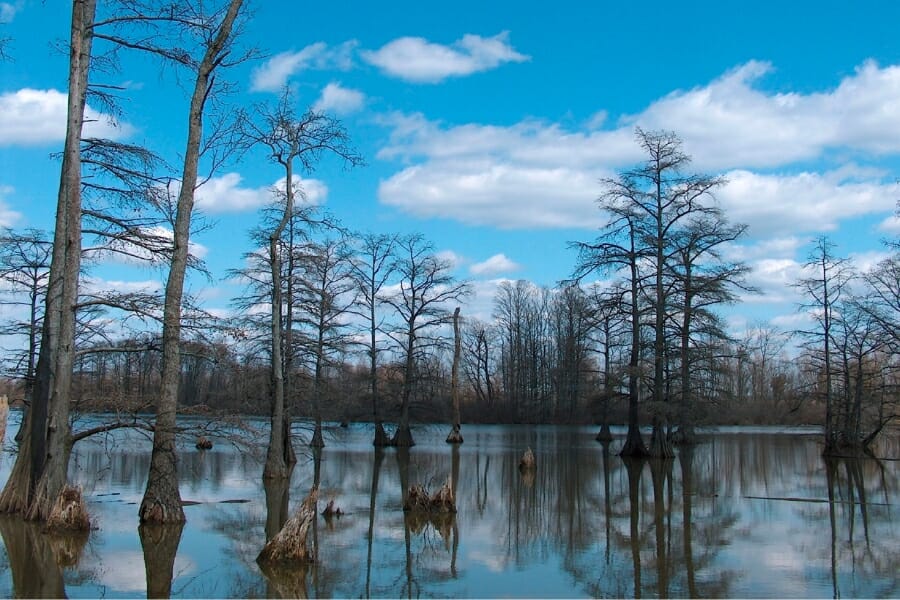
When you think of Illinois, you often picture vast farmlands and open skies, and Fayville fits right into that imagery. It has a beautiful mix of flat plains and occasional gentle hills.
Diving deep into Fayville’s geology, beneath the surface lies layers upon layers of sedimentary rock. If you have a keen eye, there’s a treat waiting for you: agates!
If you want to head to Fayville for a day of exploration, the journey is relatively straightforward. Though it might not be as prominently marked as some of the bigger cities, a good map or GPS will guide you straight here. The roads, typical of Illinois, are well-kept and surrounded by scenic views.
Where we found agates in Fayville
The area stream gravels of Fayville provide the right conditions for agates to form, so if you want to find them, search through that area.
Warsaw

Warsaw sits proudly along the banks of the Mississippi River, which gifts it with stunning river views and landscapes shaped by the flow of this mighty waterway.
The geography here is a captivating blend: on one side, you have the vast, flowing river, and on the other, the gentle rolling hills and plains that Illinois is famed for. Below its surface are layers of sedimentary rocks, where you can find stunning agates.
If you’re gearing up for a trip to Warsaw, you’ll be happy to know it’s pretty easy to get to. It’s accessible via well-maintained roads, and its position by the river means it’s hard to miss!
Where we found agates in Warsaw
You can find water-worn pebbles of agates if you explore the local gravel pits of Warsaw.
Other Great Places To Find Agates in Illinois
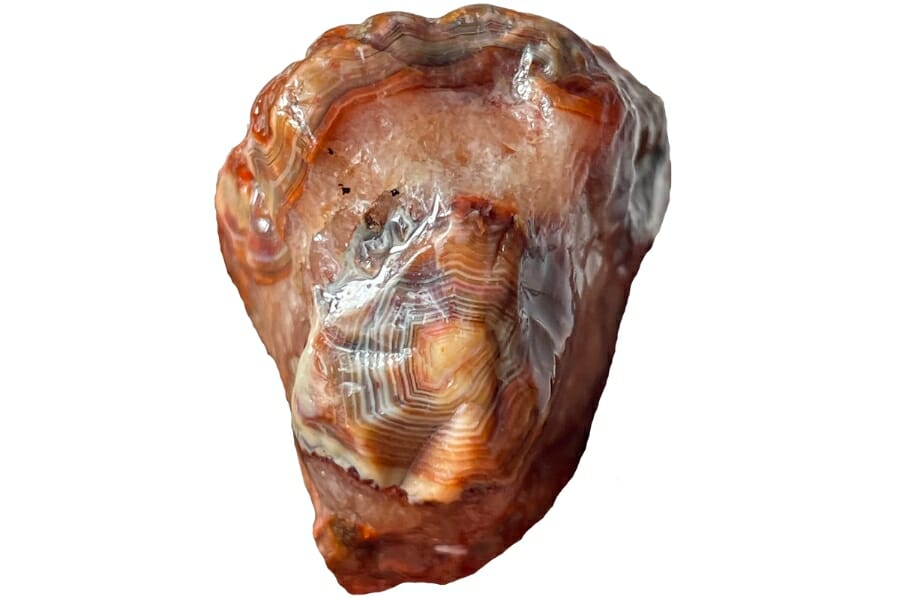
If you want more options where you can find agates in Illinois, below are a few more guaranteed sites that you can visit:
Our recommendations by county
| County | Location |
| Jo Daviess | East Dubuque area gravel pits |
| Kane | Road Fill Corporation Gravel pit |
| McHenry | Materials Service Sand and Gravel Dycore Corporation, Algonquin Plant |
Additional areas you can find agates
To guide you through your search, here are the specific areas that we recommend you pay close attention to when trying to find agates in Illinois. These are where other rockhounds have reported finding them:
Rivers and Riverbanks
Rivers and riverbanks are like nature’s conveyor belts for precious rocks and gems, including agates. When a river flows, it carries with it various rocks and minerals from its source and along its path. Over time, these rocks get tumbled and polished by the water.
Agates, being harder than many other stones, resist erosion and end up standing out among the smoother pebbles on riverbanks. In Illinois, this process is amplified because of its numerous rivers.
Quarries
Quarries are like massive scoops into our crust, revealing layers of rock and minerals that have been hidden for years. In the process of digging and blasting, they can uncover precious gems like agates that might otherwise stay buried deep below.
When quarries penetrate volcanic rock layers, they can bring agates closer to the surface. Illinois has numerous quarries that tap into these ancient layers. The combination of volcanic and sedimentary rock zones in our state makes quarries ideal agate-hunting sites.
Streams and Creeks
Streams and creeks are nature’s winding pathways, gently moving rocks and gems from one place to another. As water flows, it picks up and carries various stones, tumbling and smoothing them along the way. This action often reveals the hidden patterns and colors of agates.
Agates, which are tougher than many rocks, shine brightly after being naturally polished by the water’s movement. In Illinois, streams and creeks are especially exciting places for agate seekers.
Common Agate-Hunting Questions
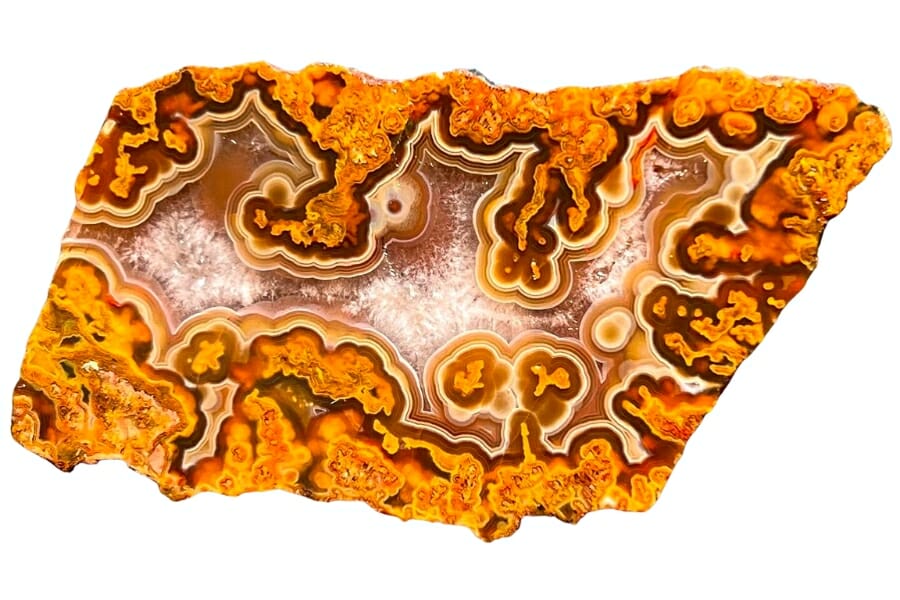
Before you start your journey here, we’ll answer the most common question among the other agate hunters that have come to Illinois before you:
Is it illegal to collect agate in Illinois?
The legality of collecting agates largely depends on where you are in Illinois and who owns the land. On private property, you must obtain permission from the landowner before collecting. Without permission, it can be considered trespassing or theft.
On state-owned lands, such as state parks or natural areas, collecting rocks, minerals, or fossils is generally prohibited to preserve the natural environment.
Always check local regulations or consult with the specific land management agency before you start collecting. For more information, visit the website of the Illinois Department of Natural Resources (IDNR).
The Best Places To Buy Agates In Illinois

Another guaranteed way to find agates in Illinois is by visiting our trusted local rock and mineral shops. An advantage of this is that you’ll also get to see, touch, and even bring home agates from other sides of the world.
Below are some of our recommended shops:
- Crystal Earth Rock Shop – 1125 S Main St J, Lombard, IL 60148
- Dave’s Down to Earth Rock Shop – 711 Main St, Evanston, IL 60202
- High Ho Gems – 19622 Wolf Rd Unit 1, Mokena, IL 60448
- On The Rocks – 5709 N Clark St, Chicago, IL 60660
- The Treasure Shop – 314 Franklin St, Geneva, IL 60134
If you have any recommendations for our list please leave a comment below!

